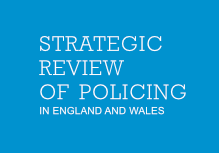Publications
Strategic Review of Policing in England and Wales: Final Report
This concluding report from the Strategic Review of Policing in England and Wales sets out a root-and-branch reform agenda for policing in a world that is changing as radically as that in which Sir Robert Peel founded the Metropolitan Police in 1829.
The report sets out a long-term strategic vision for English and Welsh policing, including 56 recommendations for a modern police service capable of meeting the challenges of the 21st century.
Download a summary of the final report
Strategic Review of Policing in England and Wales: Phase 1 Report
This report represents the culmination of the first phase of the Strategic Review of Policing in England and Wales. It describes the nature of the public safety and security challenge facing the country as we look to the 2020s and 2030s.
The public safety challenges facing England and Wales have been transformed by technology, globalisation and the rise of more complex social problems. As a result, the task of policing has become more demanding.
Insight Paper 1 - Policing and the public: Understanding public priorities, attitudes and expectations
This first Insight Paper from the Strategic Review of Policing in England and Wales provides 10 key insights that can help us think about the challenge the police face in maintaining the support of the public while also meeting new threats.
Insight Paper 2 - Revisiting the police mission
This Insight Paper examines the enduring question ‘what are the police for?’ The general nature of the police role, present from the very beginning of the modern police service, has meant that the boundary between responsibilities of the police and other services has often been blurred. But rather than simply rehearsing old arguments, this paper seeks to move the debate on into fresh territory.
Insight Paper 3 - Taking prevention seriously: The case for a crime and harm prevention system
The Strategic Review’s third Insight Paper makes the case for much greater investment and coordination in the prevention of crime and wider harms. It sets out the rationale for a shift to prevention in relation to crime and other threats to public safety; it looks at what we understand by prevention and it applies a prevention framework to three areas of crime and sketches to illustrate what a preventative approach might look like.
